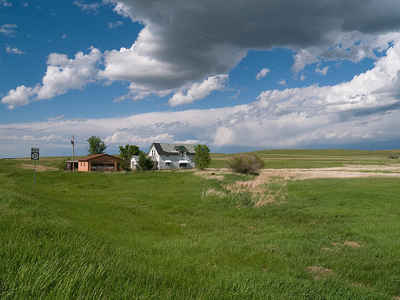North Dakota State Information Guide
Capital: Bismarck
November 02, 1889 (39th state)

Both rural and agricultural, with grain farms and cattle ranches, North Dakota gets its name from the Dakota division of the Sioux Indians who lived on the plains before the Europeans arrived. "Dakota" means "friend." French-Canadian soldier and fur trader Pierre Gaultier de Varennes was the first known white explorer to visit the home of the Dakota in 1738. North Dakota was one of the last areas of the frontier to be settled by non-Native Americans, and even today, it's not a highly populated state. North Dakota, whose capital is Bismarck, joined the Union on November 2, 1889 as the 39th state. Appropriately, the state flower of North Dakota is the wild prairie rose.
North Dakota State Creed
Written by Frank L. McVey, former President of the University of North Dakota, first found in the 1926 Manual for the State of North Dakota
"We believe in North Dakota, in the beauty of her skies, and in the glory of her prairies.
We believe in the People of North Dakota, in their strength of Body and Mind, in their High Sense of Right, and in their Desire to establish a Great Commonwealth wherein the things that count for Human Welfare shall be first.
We believe that by Thought and Act we can magnify our State and the Life of our People, bind the East and the West, the North and the South by Roadways, Communication and Good Will, and give our Sons and Daughters the Opportunity to Work at Useful Tasks within our borders.
We pledge to those seeking new homes the Hand of Hospitality and extend to them a Welcome to our Commonwealth where they may find Peace and Happiness.
We pledge that the freedom our Fathers won here and elsewhere shall continue as the Heritage of our Children.
We, as a People, because of growing Intelligence and a Nobler Outlook, seek Unity of Purpose; we desire to lead a Richer Common Life, and hope to render a Larger Service to the State and the Nation."
[This state creed has never been officially adopted].
North Dakota State Resources & State Information
North Dakota Almanac: Facts and Figures, Economy, and Geography
North Dakota College, Universities, and Schools
- North Dakota Colleges and Universities
- North Dakota Public Colleges
- North Dakota Community Colleges
- North Dakota Private Colleges & Independent Schools
North Dakota Cities Colleges:
North Dakota Medias
North Dakota History, Timelines, and Famous People
- North Dakota First Inhabitants
- North Dakota History
- North Dakota Timeline
- North Dakota Famous People
- North Dakota State Facts
North Dakota Counties
North Dakota Symbols
Other North Dakota Resources
- North Dakota Missing Children
- CapitolImpact.com - Government Gateway
- Kaiser StateHealthFacts.org - Health Facts
- National Center for Missing & Exploited Children
- Encyclopedia Britannic
- CareerBuilders - Jobs
- National Park Guide
- State Home Page
- State Transportation Department

The 50 US States





